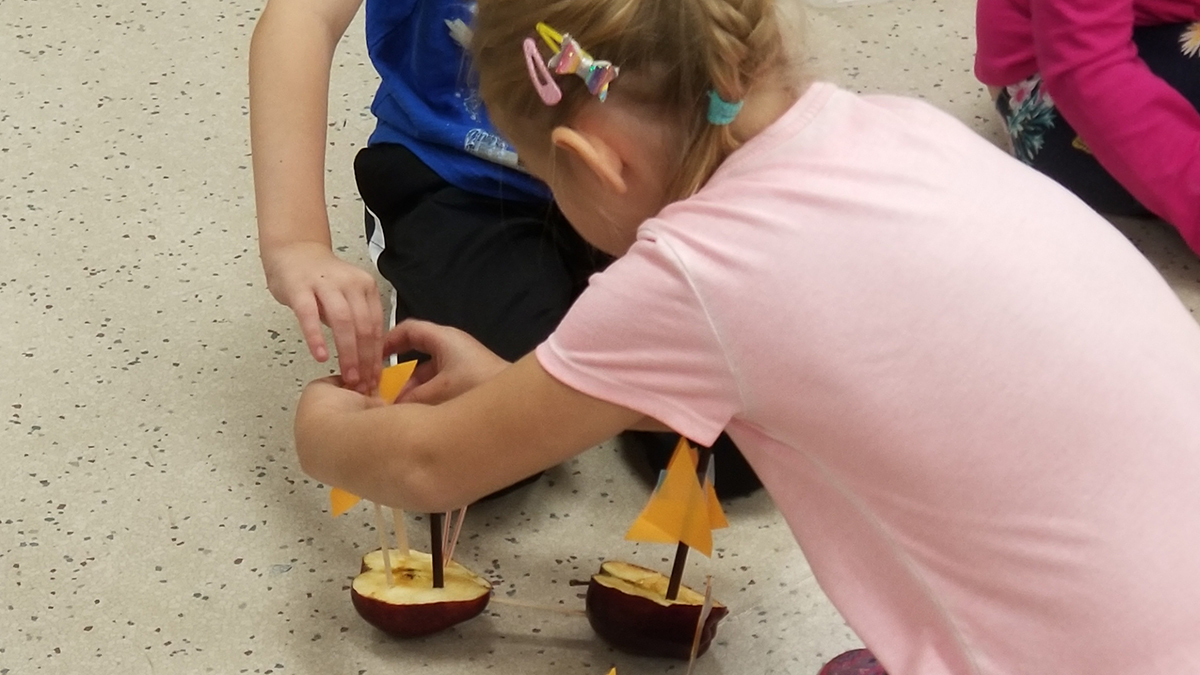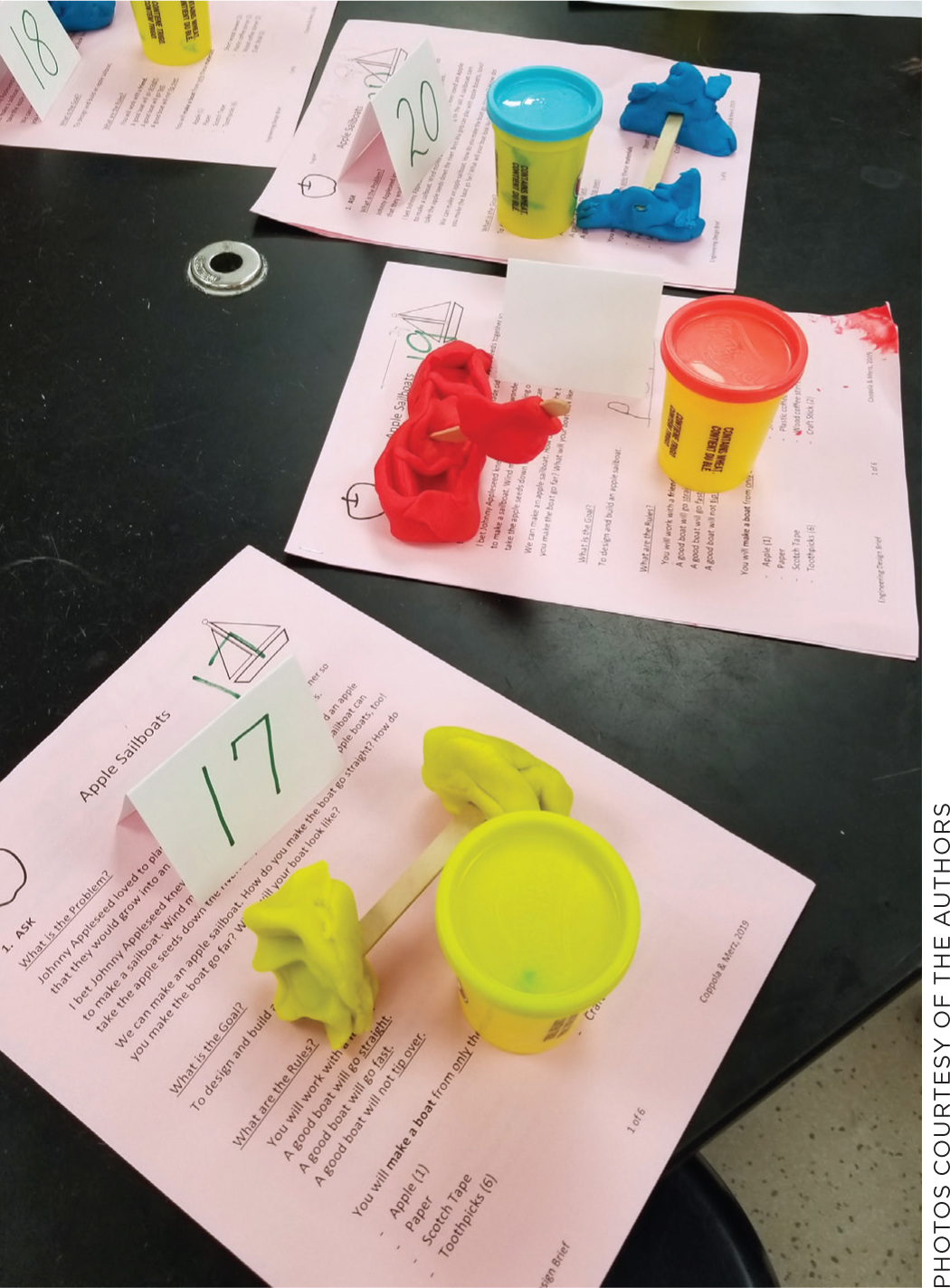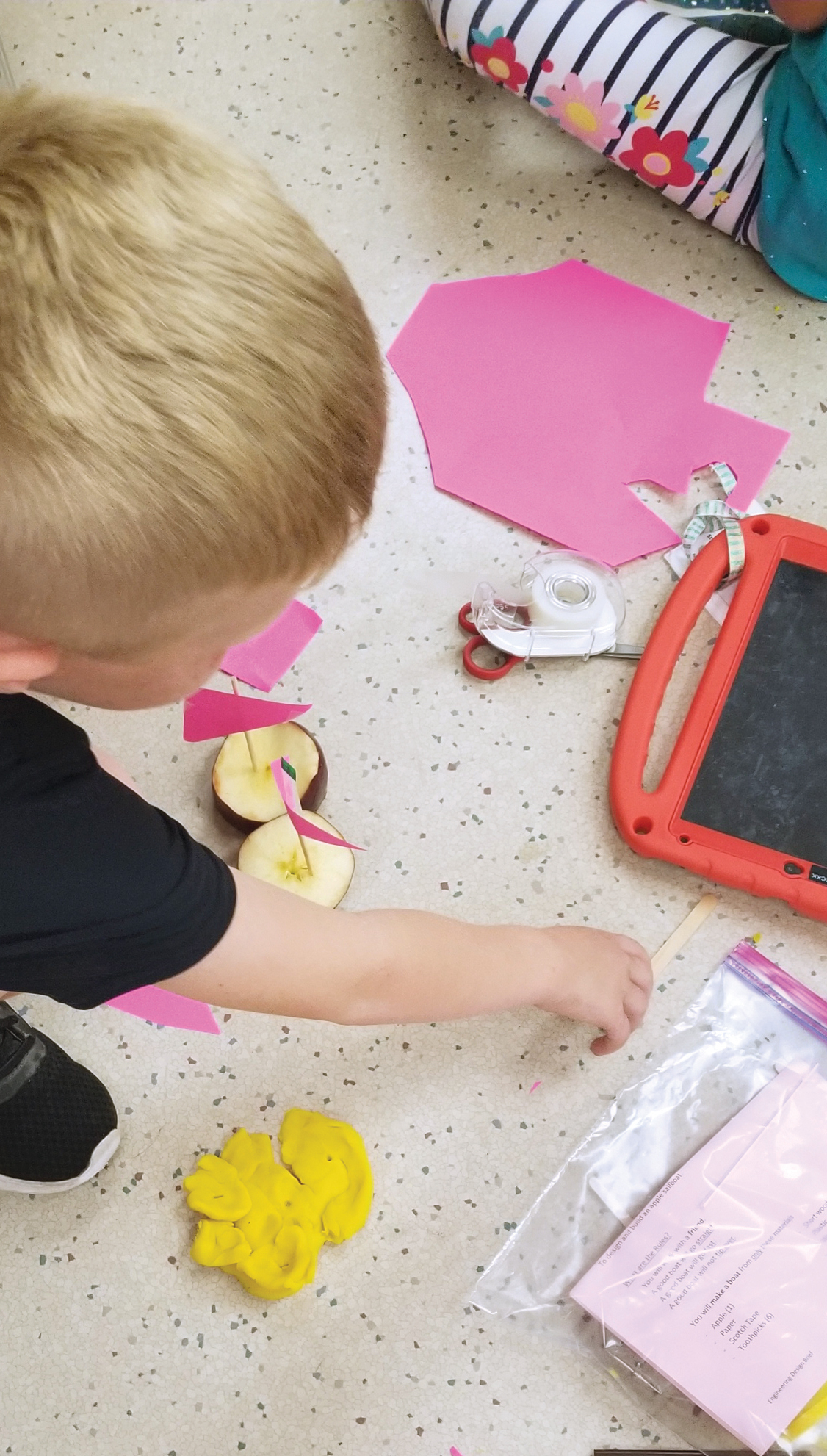feature
Sailing into Engineering
Apple boats offer an opportunity to integrate design into a popular Kindergarten lesson.
Science and Children—July/August 2020 (Volume 57, Issue 9)
By Matthew Perkins Coppola and Alice Merz

Each fall at harvest time, young students in our part of the Midwest visit apple orchards to learn more about the life cycle of plants. This tradition is one part of a larger unit centered on apples, integrating life science with language arts and social studies. We partnered with kindergarten teachers at several schools to design and teach a five day apple-themed engineering design unit. Building on our fascination with things that float and how we apply forces to make them move, we turn apples into sailboats. This lesson utilized inexpensive and common materials, many of which are easily substituted, making it an accessible choice for at-home investigations by students or families.
Day 1: Scientific Investigations
We begin the day with an introduction to forces. First, we direct the students’ attention to a foam apple sitting on the table. Then we pull up on the apple, lifting it high above our heads. We ask the students to predict what will happen when we let go of the apple, then demonstrate. We share the story of how an infamous falling apple inspired Sir Isaac Newton to investigate gravity. We talk about how the Earth pulls down on the apple, causing the apple to have weight. We draw the apple on the board, then a large arrow labeled “PULL.” We add the words “weight” and “gravity.” I point out that the weight of my foam apple is one Newton, in honor of Sir Isaac.
Next, we note how the apple rests on the table. “Why doesn’t the apple fall?” We add an up arrow to the diagram, labeled “PUSH.” We say these two forces must be in balance in order for the apple to stay put. The downward pull of gravity is balanced by an upward push from the table. Surely, the apple would fall if there was not a hard, solid surface to support it! “What soft surface could we test to see if it will push on the apple?”
We come up with the idea of water because it can “give way” to an object and not provide a solid support. We wonder: Will water push up on the apple to make it float? Or will the apple sink to the bottom? The water does support the apple! The water pushes up with enough force to balance the pull down of the weight. Inspired by Keeley (2013), we investigate other fruits and vegetables, such as pumpkins, grapes, blueberries, strawberries, potatoes, and cucumbers. Students make predictions based on size, weight, or how much air they think is inside. The students shriek with excitement as we test our predictions!
When an object sinks, we talk about how the forces are not balanced. We record our results in a table on the board and notice that neither size nor weight alone explains why something will float or sink. We stop here, just short of formally introducing the concept of density and avoid trying to explain how displaced volumes of water determine the upward buoyant force. For now, this mystery will have to wait.
Day 2: Ask—Knowing the Problem
Our engineering challenge is organized using an Engineering Design Process for Kindergarten (EDP for K) Lottero-Perdue et al. 2016), a developmentally appropriate four-step approach: (1) Ask; (2) Imagine; (3) Try; (4) Try Again. We print several apple-themed EDP for K posters and place them around the room to serve as visual reminders (see NSTA Connection)
We begin the Ask phase with our design brief, inviting the children to follow along as we read the narrative. Our design brief (see NSTA Connection) also states the criteria for success and design constraints. The design brief helps children explore the following questions: (1) What is the problem? (2) What is the goal? and (3) What are the rules? Our narrative introduces the problem:
Johnny Appleseed came to our region in the 1800s. He loved to plant apple trees… I wonder if he ever used an apple to make a toy sailboat.
We can make an apple sailboat. How do you make the boat go far? How do you make it go fast? How can you keep it from capsizing or falling over in the water? What will your boat look like?
We read and discuss the goal and the rules. The goal is to design and build a toy sailboat from an apple and other materials. The rules emphasize the need to work with a partner, make the boat go to the end of the bin, and use the provided materials.
Next we consider what we know about sailboats. I draw a picture of a sailboat on the board. As I label each part I hold up a piece of paper with the words in all caps: HULL, MAST, SAIL, and KEEL. The students tell me that the boat has weight, so I draw and label an arrow “WEIGHT” on the board to represent the downward force. The water pushes up on the boat with the same force, so I draw an arrow of equal length pointing up and label it “WATER.” I ask, “What force pushes the boat forward?” The students tell me that wind pushes on the sail to move the boat forward. I draw an arrow and label “PUSH.” I draw a fourth arrow, shorter in length, to represent the DRAG force.
Day 3: Imagine—Brainstorming with Maquettes
The next step in the EDP for K, Imagine, is all about brainstorming about the materials and how they can be used together to solve the problem. Before passing out materials, we open a can of play dough and roll it into the shape of an apple. “Let’s think of some ways we can divide the apple to make the hull of the boat. Why apple? Because we know apples float. But how do we cut it to make a hull? Are there other ways we could cut the apple?”
After brainstorming together, we pass out dough and a wooden stick to each pair of students. We explain that the dough will not be their boat but it will look like their boat. The students divide the dough in half, and then each begins fashioning their own designs. Some use the stick as the mast with a sail and hull made of dough.
Working with play dough first allows students to create multiple designs. We call this physical model a maquette (Perkins Coppola and Merz 2019). A drawn design is limited to two dimensions, requires scale and perspective, and can fail to capture critical details. The maquette represents student thinking in three dimensions, can be manipulated or articulated, and serves as an object to focus discussion of the design. We ask students to take photos and videos as they work, explaining their design choices. The children store their maquette in labeled plastic bags.
Day 4: Imagine—Brainstorming with Materials
Today we tell the students that we are going to brainstorm how to use the provided materials to make sailboats. The students already know that apples make a good hull because they float. Properties of the other materials and their potential uses are less clear.
We ask, “What material will we use to make the sail?” I hold up the word “SAIL” and then cut a large triangular sail from the paper. Then I cut out a smaller sail. “Do you want to use a large sail or a small sail?” I rotate the paper, showing multiple ways the triangle could be positioned with the sail. I repeat this process for other shapes before moving on to brainstorm about the mast. “Which material do we use? How tall? How many? Where do I place it?” We put the different candidates for the mast into a play dough hull, one at a time. I discuss safety with the students, noting the pointy ends can hurt people and reminding everyone to use scissors to cut paper only.
We pass out materials, minus the apple, which students promptly begin examining and sorting. Again using their maquette, the children investigate how the size and placement of the sail or mast makes the boat tip over. They blow into the sail to see how well it catches the wind. Each pair of students decides on a final design, document with photos and video, then place the maquette and materials back into their containers.
Before the next day, we review the photos and videos for potential safety concerns and feasibility (e.g., Can it be built in a reasonable time with the available resources?). This process helps us to anticipate potential problems and prepare probing questions.
Day 5: Try and Try Again
We begin the Try step of the EDP for K with another safety discussion. These apples are not for eating. This water is not for drinking and could cause students to slip. The fan blades are not to be touched. Knives are for adults only. We again review the goals and rules for the challenge.
The students wait for us to come to their table to cut an apple into the requested hull shapes. The remainder of the dough shows us how to cut the apple. Some negotiation may be required to make the best approximation. Occasionally a spoon or apple corer are helpful scooping out parts of the apple. Leftover pieces stay with the group to use later.
Then the children create their designs. Once complete, they test the design at one of several testing stations. We begin by discussing safety. A small box fan operated by the teacher provides the wind to push the apple sailboat across a tub of water. Water and electricity together pose hazards, so we keep the fan a safe distance and avoid getting it wet, plugging it into an appropriate GFCI outlet. Smaller battery-powered fans are a good substitution, though care must be taken with the spinning blades. One child carefully places the boat into the tub while the other documents the test with a video. Other students, waiting their turn to test, gather around to observe.
Apple sailboats tend to do one or more of a combination of things: (1) tip over (capsize), (2) slow down and stop, (3) flap in the breeze, (4) drift to one side, or (5) spin. We allow each group to test a couple of times to see if the results are consistent. Each test gives them another opportunity to notice how specific features of the design cause the sailboat to behave as it does.
This process of noticing and reflecting marks the transition into the Try Again step of the EDP for K. Rather than waiting until everyone has tested, we encourage each pair to reflect immediately on what worked and what they might adjust. Knowing precisely what to change or keep is rarely straightforward for trained engineers, much less young children. Thus, we use probing questions to encourage a “tweak-and-try” approach to improving the sailboats.
Tweak-and-try differs from random guessing in that it is grounded in the students’ observations. Engineers use such evidence to make informed decisions about what to change (Cunningham 2018). We discuss what the students notice, what they want to change, why they think this change will address the problem, and what they predict will happen. For each Try Again, the children focus on a new goal: make the boat go faster, go farther, keep it from tipping over, and so on. We ask the students to change only one thing at a time so they can know if and how the adjustment impacts the performance of the boat. The conversation is short and adjustments are usually small, allowing the students to tweak-and-try multiple times.

Working with play dough first allows students to create multiple designs.

Students models are translated to apple form.
Some examples of adjustments we discussed: One group wanted to try the boat without a sail to see if that would affect the speed and distance this boat traveled. Rather than taking our word, they observed the function of the sail for themselves. Another group wanted to keep the boat from tipping over. The original sails were made of slices of apple. During testing they recognized the apple sails were too heavy and replaced them. One design with a wedged-shaped hull kept tipping over. Unlike other boats tipped by large or heavy sails, this hull and mast tipped over even when the sail removed. We encouraged them to figure out how to add an extension (outrigger) to balance the boat.
When students are stumped as to what to do revise, we ask them to identify the first problem they wish to address, then point out the part of the boat they may want to adjust. We recognize the limits on the children’s prior knowledge and experience with sailboats, and the importance of trial and error in this activity in constructing a broader foundation.
For example, one boat suffered from a wildly flapping sail. We offered, “How can you make the sail firmer to keep it from flapping?” This prompt drew attention to the firmness of the sail material without telling the students specifically what to adjust to improve stability. The students are still in control, free to reject our suggestions and tweak as they see fit.
For groups with sailboat designs that move well, we encourage them to see how the boat performs when one of the testing conditions changes. Wind speed and weight are two of our favorites. We change wind speed with a turn of the knob, increasing the force on the sail. Students quickly observe that increasing the pushing force is as likely to tip the boat over as it is to increase the speed.
We change the weight by adding “passengers” or other cargo to the deck. This added force must be spread evenly to prevent tipping. Students observe how increasing the weight changes the balance: Does the water still support the heavier boat? Does a heavier boat move forward the same as a lighter one?
Reflecting on Learning
We observed firsthand how young children can use scientific investigation and engineering design to explore an anchor phenomena such as sailboats. Throughout the week long unit, the children became more comfortable with the engineering design process. Through the tweak-and-try approach, students used observational evidence to make decisions about what to change first, using rapid cycles of redesign and testing to construct foundational understanding. As a steady breeze fills the sails of the boat, may your study of apple sailboats direct and fill the minds of your students with new knowledge and curiosities!
NSTA Connection
Download the EDP for K poster and design brief at https://www.nsta.org/online-connections-science-and-children.
Matthew Perkins Coppola (perkinsm@pfw.edu) is an assistant professor of science education and director of the Northeast Indiana Regional Science and Engineering Fair, and Alice Merz is an associate professor of education, both at Purdue University Fort Wayne in Fort Wayne, Indiana.
Engineering Physical Science Early Childhood


